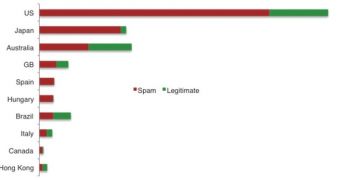Some people would probably expect Ukraine not to be a hotspot for spam and cybercrime with the civil unrest and everything. However, Cloudmark has found that the country is still among the top 20 spam sources.
The company has released its Global Messaging Threat Report for the first quarter of 2014. The study shows that Ukraine is also in the top 10 countries when it comes to the number of IP addresses that have been blacklisted by Cloudmark.
Most of the spam messages originating in Ukraine are targeted at the United States. Significant volumes of spam also go to Japan and Australia, but countries such as the UK, Spain, Hungary, Brazil, Italy and Canada are also targeted.
Of course, Ukraine is also hit by spam. Most unsolicited emails come from China and from within Ukraine itself.
“The recent civil unrest, change of government, and Russian military action has had little impact on Ukraine’s spam output. There were some sharp spikes just before and during the early stages of the protests, but we are not seeing any long-term impact, either positive or negative,” the report reveals.
While Ukraine might be a top spammer, it’s not the worst. Most IP addresses blocked by Cloudmark are in the United States and Romania. China, Russia, Germany, Iran, India and Belarus are also on the list.
Cloudmark’s report also points to the “death notification” spam campaign that has made the rounds over the past months. Experts believe that these types of spam emails are a result of the arrest of the BlackHole exploit kit’s author.
With the exploit kit out of the picture, cybercriminals are resorting to scare tactics. Another perfect example is the spam emails that inform internauts in the United Kingdom that they might have cancer.
As far as SMS spam is concerned, sport fans in the UK have received a lot of texts advertising various casinos and betting offers. The spike was recorded on January 19, when Chelsea played Manchester United. On that day, 16% of SMSs in the UK referenced sport books and casinos.
Last week, Cloudmark highlighted the fact that April 12 marked the 20th anniversary of the first large-scale commercial spam campaign.
If you’re interested in learning more about the history of spam, you can check out the infographic put together by Cloudmark. The complete Global Messaging Threat Report for Q1 2014 is available on Cloudmark’s website.

 14 DAY TRIAL //
14 DAY TRIAL //